 W
WAcreichthys radiatus, commonly known as the radial filefish or the radial leatherjacket, is a species of demersal marine fish which belongs to the family Monacanthidae widespread throughout the tropical waters of the western Pacific Ocean, including the Ryukyu Islands, the Philippines, the oriental part of Indonesia, Papua New Guinea, the north east area of Australia, and New Caledonia. It is a small size fish that can reach a maximum size of 7 centimeters in length.
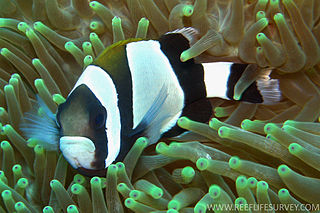 W
WAmphiprion latezonatus, also known as the wide-band anemonefish, is a species of anemonefish found in subtropical waters off the east coast of Australia. Like all anemonefishes, it forms a symbiotic mutualism with sea anemones and is unaffected by the stinging tentacles of its host. It is a sequential hermaphrodite with a strict size-based dominance hierarchy; the female is largest, the breeding male is second largest, and the male nonbreeders get progressively smaller as the hierarchy descends. They exhibit protandry, meaning the breeding male changes to female if the sole breeding female dies, with the largest nonbreeder becoming the breeding male.
 W
WAnchoa lyolepis, the shortfinger anchovy, is a species of anchovy native to the western Atlantic Ocean from New York to Brazil. This species can reach a length of 12 centimetres (4.7 in) TL, though they usually do not exceed 9 centimetres (3.5 in) TL. This species is important to local subsistence fisheries and is commonly used as bait.
 W
WAndersonia leptura is a species of catfish of the family Amphiliidae, and is the only species of the genus Andersonia. This fish grows to about 50.0 cm (19.7 in) in total length; it is found in the Omo, Niger, and Upper Nile Rivers and the Lake Chad basin, and is also known from Lake Debo. Although previously considered to be toothless on the lower jaw, dentition has been found on the premaxilla and the dentary. The teeth are embedded in the mucous sheath that covers the head and extends into the oral cavity, which makes the teeth difficult to see with the naked eye.
 W
WCallionymus beniteguri, the White-spotted dragonet, is a species of dragonet native to the water around Japan and the East China Sea. This species grows to a length of 16 centimetres (6.3 in) SL. This species is of importance to local commercial fisheries.
 W
WThe Knysna seahorse or Cape seahorse is a species of fish in the family Syngnathidae. It is endemic to the south coast of South Africa, where it has been found in only three brackish water habitats: the estuary of the Keurbooms River in Plettenberg Bay, the Knysna Lagoon, and the estuarine portion of the Swartvlei system in Sedgefield. The limited range of this seahorse puts it at great risk of extinction.
 W
WChiloglanis niloticus is a species of upside-down catfish native to the Nile River and Niger River. This species grows to a length of 4.5 centimetres (1.8 in) SL.
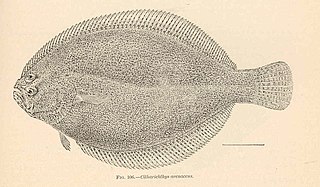 W
WCitharichthys arenaceus, the sand whiff, is a species of flatfish in the large-tooth flounder family Paralichthyidae. This demersal marine fish inhabits the western Atlantic Ocean, occurring in shallow tropical coastal waters, as well as in estuaries, bays, and lagoons. It ranges from Florida, United States, in the north to the West Indies and Brazil in the south.
 W
WCoelorinchus kishinouyei, the Mugura grenadier, is a species of rattail that occurs in the waters around Japan and Taiwan where it is found at depths of 250 to 450 metres. This species grows to a length of 36 centimetres (14 in) TL and is of minor importance to local commercial fisheries.
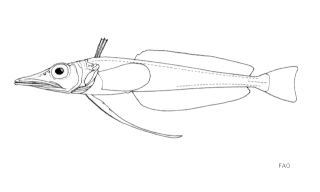 W
WCryodraco antarcticus, the long-fingered icefish, is a demersal species of crocodile icefish only found in the Southern Ocean. It is found near the South Orkney Islands, the Antarctic Peninsula, the Weddell, Bellinghausen, Ross and Davis seas at depths of 90 to 600 m.
 W
WEncrasicholina purpurea, the Hawaiian anchovy, known in Hawaiian as nehu, is an anchovy of the family Engraulidae that is endemic to the Hawaiian Islands.
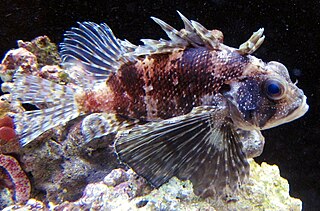 W
WDendrochirus barberi, the Hawaiian lionfish, is a dwarf lionfish from the Eastern Central Pacific. It occasionally makes its way into the aquarium trade. It grows to a size of 16.5 cm in length.
 W
WJayakar's seahorse is a species of coastal fish of the family Syngnathidae. It is found in the Western Indian Ocean, from the Red and Arabian seas to the central coast of Pakistan. It lives in seagrass beds, algae, soft-bottom substrates, sponges, and rocky habitats, where it can grow to lengths of 14 centimetres (5.5 in). It can inhabit depths to 20 metres (66 ft), though it is more commonly found at 2–3 metres (6.6–9.8 ft). It is expected to feed on small crustaceans, similar to other seahorses. This species is ovoviviparous, with males carrying eggs in a brood pouch before giving birth to live young. Individuals reach sexual maturity at 11 centimetres (4.3 in). The specific name and the common name honours the Indian physician, linguist and ichthyologist Dr. Surgeon-Major Atmaram Sadashiv "Muscati" Jayakar (1844-1911).
 W
WLeporinus muyscorum is a species of freshwater fish in the genus Leporinus. It is endemic to Colombia, where it occurs in the Magdalena River Basin and Atrato River. The species was first described by Franz Steindachner in 1900.
 W
WParapercis snyderi, commonly known as redspotted sandperch, lyretail grubfish or flagfin weever, is a species of marine fish native to the Indian and Pacific Oceans. It is a member of the sandperch family Pinguipedidae, form the percomorph order Trachiniformes.
 W
WPareutropius debauwi is a species of fish in the Schilbeidae, the schilbid catfishes. Its common name is African glass catfish. It is native to Africa, where it can be found in the Central African Republic, the Republic of the Congo, the Democratic Republic of the Congo, and Gabon. It is widespread and faces no serious threats.
 W
WThe Ripon barbel is an East African ray-finned fish species in the family Cyprinidae. A huge barb, its maximum recorded total length is 90 cm (35 in).
 W
WSchizodon borellii is a fish in the family Anostomidae from South America.
 W
WThe silver chimaera is a species of fish in the family Chimaeridae found near Australia, China, Japan, North Korea, South Korea, New Caledonia, the Philippines, Taiwan, and Vietnam. Its natural habitat is open seas.
 W
WSturisoma aureum is a species of armored catfish endemic to Colombia where it is found in the Magdalena, San Jorge and Cesar River basins. This species grows to a length of 20 centimetres (7.9 in) SL. This species can be found in the aquarium trade.
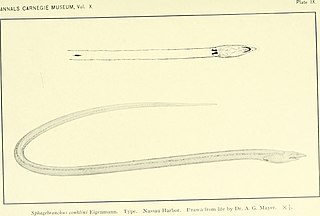 W
WThe Surf eel is an eel in the family Ophichthidae. It was described by Barton Warren Evermann and Millard Caleb Marsh in 1900, originally under the genus Sphagebranchus. It is a marine, tropical eel which is known from the western and eastern Atlantic Ocean, including Bermuda, the Bahamas, Florida, USA; Puerto Rico, the Virgin Islands, northern South America, and St. Helena Island. It dwells at a maximum depth of 35 metres (115 ft), most often between 5 to 15 metres, and forms burrows in sand bottoms in surf areas, from which its common name is derived. Males can reach a maximum total length of 45 centimetres (18 in).
 W
WSynodontis granulosus is a species of upside-down catfish endemic to the Democratic Republic of the Congo, Burundi, Zambia, and Tanzania, where it is only known from Lake Tanganyika. It was first described by Belgian-British zoologist George Albert Boulenger in 1900, from specimens collected at multiple points along the shore of Lake Tanganyika. The species name comes from the Latin word "granulum", meaning of grain, and refers to the granular papillae present on the skin of the fish's body.
 W
WSynodontis ocellifer, known as the ocellated synodontis, is a species of upside-down catfish native to the rivers of northern and western Africa. It has been reported in 10 countries, including Burkina Faso, Cameroon, Chad, Gambia, Ghana, Guinea, Mali, Niger, Nigeria, and Senegal. It was first described by Belgian-British zoologist George Albert Boulenger in 1900, from specimens collected in Kunchow Creek, in Gambia. The species name ocellifer comes from the Latin word ocellus, meaning "eye", and the Latin word ifer, meaning "to carry", which refers to the black spots, possibly with white centers found on the sides.
 W
WTropheus annectens is a species of cichlid endemic to Lake Tanganyika, where it is found on a substrate consisting of large, fixed rock. This species can reach a length of 8 cm (3.1 in). It can be found in the aquarium trade.
 W
WTylochromis polylepis is a species of cichlid native to Lake Tanganyika and the Lukuga River, where it is found in swampy habitats. This species can reach a length of 43.5 cm (17.1 in). It can be found in the aquarium trade.
 W
WThe western scorpionfish is a fish belonging to the family Scorpaenidae. It is red in color. It grows to about 30 inches in length with large, broad pectoral fins and no swim bladder. They are found in the Pacific Ocean near Japan.
 W
WThe Yatabe blenny is a species of combtooth blenny found in the northwest Pacific ocean along the coasts of southern Japan and Korea. This species reaches a length of 9 centimetres (3.5 in) TL. The specific name was coined in memory of Jordan and Snyder's friend and fellow alumnus at Cornell University the botanist Riokichi Yatabe [1851-1899] who drowned in an accident while on holiday in Japan.